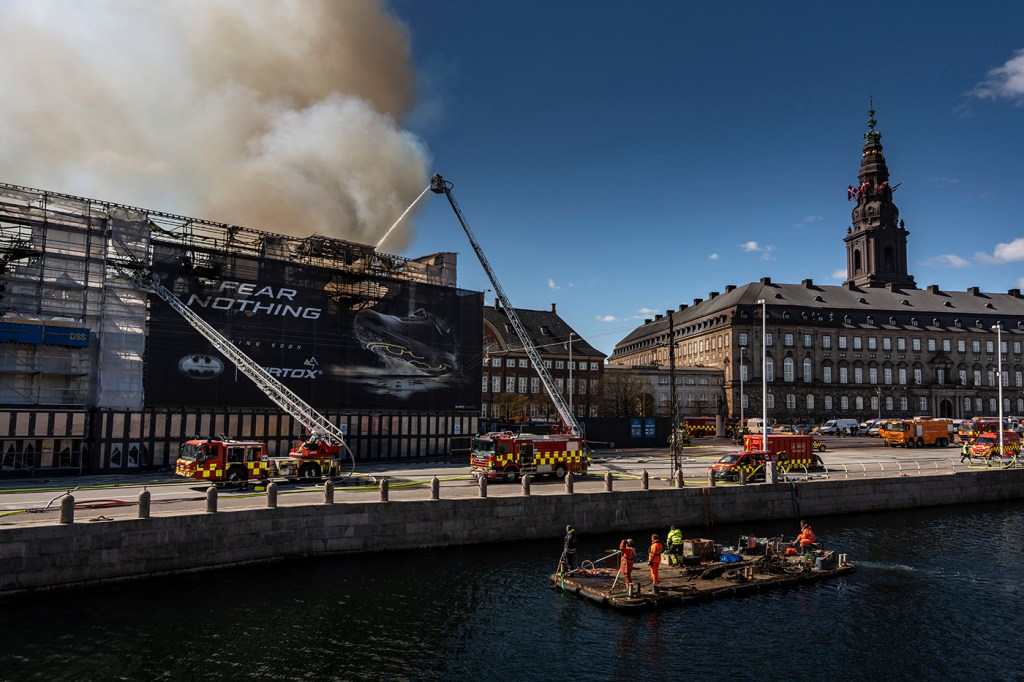What lessons can we learn from the fire at the old stock exchange in Copenhagen? Expert discusses the risk of renovations
Northeastern professor David Fannon discusses the significance of the landmark, the risks associated with renovations and the lessons that can be learned from tragedies like this.

Flames ripped through the old stock exchange in Copenhagen Tuesday morning, causing heavy damage to the 400-year-old building and destroying its 183-foot spire.
The blaze hit nearly five years after fire destroyed much of the 861-year-old Notre Dame Cathedral in Paris, which is expected to reopen in December after a massive restoration.
Also known as Børsen, the old stock exchange was being renovated when the fire broke out. First responders helped save hundreds of artifacts before flames destroyed most of the interior.
Danish Prime Minister Mette Frederiksen called the building “irreplaceable cultural heritage” and “a piece of Danish history.” King Frederik said the building is “an important part of our architectural heritage.”
Northeastern Global News spoke with David Fannon, associate professor of architecture and civil and environmental engineering at Northeastern, about the significance of the historic landmark, the risks associated with renovations and the lessons that can be learned from tragedies like this.
His comments have been edited for brevity and clarity.
Could the renovation have contributed to the fire?
If you talk to fire protection experts, firefighters, architects or engineers, anytime we’re renovating a building there is a higher risk of a fire for a couple of reasons.
First, when a building isn’t finished, the systems that protect them (alarms, sprinklers, etc.) might not be fully installed yet or might have been removed because of the renovation.
The second thing is that in the renovation process you often have people cutting things where there might be sparks from welding. Also, sometimes roofs are applied with high heat or flamed asphalt. You might be soldering copper, as well.
Can old buildings be protected with new systems?
All buildings regardless of age must meet fire code. You must have exits, doors can’t be blocked and you’re not supposed to store flammable materials. Those kinds of things apply to all buildings all the time.
Meanwhile, the building code really only affects the building when it’s first constructed. If there’s a renovation, it depends on the local authority and the scale of the renovation if new systems need to be installed.
The other complicating factor is all buildings, especially very old buildings, may have been renovated multiple times in their history.
It means that when you look at a building, you have to figure out how it was updated to meet the building standards through the years. That makes it a more complicated fire protection problem, mechanical engineering problem and structural problem.
Copenhagen’s fire chief said that the old copper roof prevented firefighters from accessing the fire. Why did this happen?
Depending on the nature of the fire, metal roofs like copper might trap and reflect heat, where another roofing material might burn through fairly quickly. That would create openings, trap less heat and prevent the fire from spreading.
Oftentimes firefighters want to ventilate the roof deliberately so they’ll cut a hole into the roof or to introduce water or other fire fighting materials.
A metallic roof like copper makes the process harder because it’s resistant to cutting. From the photos that I’ve seen it looks like this was more of a standing seam and soldered copper, which is a much more durable kind.
Why is it so important to preserve such old buildings?
Architecture tends to preserve things that people value or care about. So in the case of the Børsen building, it’s a celebration that Copenhagen had become the center of global commerce. Its prominence on the world stage was partially because of its trade empire, which is symbolized by this exchange building.
Featured Posts
Also, when you have an old building, it’s been touched by and witnessed a lot of life. People for generations have preserved history as a testament to humans wanting something to last longer than ourselves, like a way of striving toward immortality.
People have a sentimental attachment to old buildings. We certainly saw folks who were not necessarily religious being very upset by the fire at Notre Dame. It takes on a larger cultural significance.
What can architects and builders learn from this fire?
A building like this was built with old bricks that tend to be softer than modern bricks, which we cook with greater control at higher temperatures. So some bricks may disintegrate in high heat produced by fire. And spraying cold water on them could cause them to crack.
The same thing with the mortar which binds bricks together and has been used for thousands of years. Mortar is a mixture of sand, lime and water and it is water soluble. A sprinkler system in an old building like this might stop the fire but it could also wash the mortar out of the brick joints, and then you have a structural problem.
The people who built these buildings did the best job they could with the materials and knowledge they had. The way we fight fires and the way we retrofit buildings to prevent damage needs to account for our knowledge of these materials.
I always think and I try to remind my students that we must remain humble. Our knowledge can always improve and our buildings could always get better.











